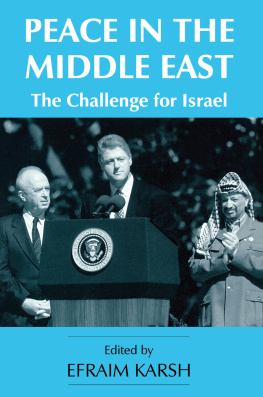Contents
Guide

The author and publisher have provided this e-book to you for your personal use only. You may not make this e-book publicly available in any way. Copyright infringement is against the law. If you believe the copy of this e-book you are reading infringes on the authors copyright, please notify the publisher at: us.macmillanusa.com/piracy.
To our families, who provide us with inspiration and hope.
Our work on this book began with a conversation we had in the spring of 2012. The Iron Dome rocket defense system had recently proved itself in combat along the Gaza Strip, and Israel was making impressive strides in other technological fields. So were Israels enemies. That February, Iran independently launched its third satellite into space, and Hezbollah was continuing to amass missiles of unprecedented quantity and quality as neighboring Syria rocked in an endless civil war.
As veteran Israeli military correspondents, we were reporting daily on the fast pace of events and conflicts in Israel, along its borders and throughout the wider region. But we felt that part of the story was missing. Israel was in the midst of one of its largest military buildups in history, acquiring new drones, stealth aircraft, submarines, accurate missiles and better-protected tanks. Israels enemies, primarily Iran and Hezbollah, were doing the same. It was an impressive arms race with potentially deadly consequences.
Over the years, the Israeli military has been a key focus of our attention. We are both veterans of the Israel Defense Forces (IDF) and continue to serve in the reserves. We have not only observed Israels conflicts but have also become part of the story. The Second Intifada, the withdrawal from Lebanon, the pullout from Gaza, the Second Lebanon War and the various IDF operations in Gaza since are all events we have covered from the front lines and, in some cases, from behind enemy lines as well.
Our work has taken us on Israeli submarines and missile ships, on Israeli helicopters and C-130s and inside armored personnel carriers with IDF infantry troops on predawn raids in the Gaza Strip and the West Bank.
Over the years, we have closely followed the IDFs evolution. We watched as the military adapted to new threatswhether it was Palestinian suicide bombers, Hezbollah rockets or Irans nuclear program. In recent years, the military has become even more vigilant, as it finds itself in a region in the throes of an unprecedented and historic upheaval. Known in the beginning as the hopeful Arab Spring, this regional earthquake has given birth to new enemies like ISIS, now deployed along Israels northern and southern borders.
Israel relies heavily on the reputation of deterrence it has worked hard to create over the years. We believe that this deterrence rests on three key pillarsIsraels purported nuclear weapons capability, its strategic alliance with the United States and the conventional capabilities of the IDF.
This book tells, for the first time, the storyof how Israel developed and created superior technology and weaponry for its military. It is a story that travels throughout Israels history, from its start as a newly founded state up to today, as that state continues to face threats and challenges from across the region.
We decided that the best way to tell this story would be to break up into separate chapters the accounts of the technology and weapons Israel excels at developing. For the most part, we have kept the story to a chronological timeline, but it also jumpsfrom the 1960s to today and then back to the 60s or 70s. We did this purposely, to give you, the reader, a complete picture of each weaponhow it was born, who the innovators were and what made them and their technology special. While each story is unique, the whole story is greater than the sum of its parts.
Pass me the binoculars, the Israel Defense Forces (IDF) chief of staff, Lieutenant General Benny Gantz, said to the officer next to him. He lifted the lenses to his eyes. Images from miles away came into sharp focus as he squinted under the winter sun.
Gantz was standing high atop Mount Kabir, doing something he loved: assessing his domain and exploring every inch of the country he was tasked with protecting.
He turned north and captured a clear view of the snowcapped peak of Mount Hermon along Israels border with Syria. A quarter-pivot around to the east and he could scope out Jordan. Just below, a mere nod down with his binoculars, he was able to peer into the city of Nablus, home to about 130,000 Palestinians.
Those views provided a quick reminder of how small Israel really is. There is no such thing as strategic depth, Gantz stood there thinking. The enemy simply sits right up alongside us.
Whats that, over there? Gantz asked Colonel Nimrod Aloni, the regional brigade commander who, like the chief of staff, had begun his military career in the paratroopers. That, Gantz said, pointing, the big white building with all the windows?
Pushing aside his firearm, Aloni adjusted his own pair of binoculars. Oh, he said. Thats the shopping mall.
Nablus is not just any Palestinian city. During the Palestinian unrest of 2000, known as the Second Intifada, Nablus had become the home for Israels most wanted. At the time, Gantz had been the commander of the IDF division responsible for the West Bank. Terrorists from Islamic Jihad and Hamas set up bomb labs and headquarters throughout the twisty stone maze of Nabluss Casbah, or old city. Founded by the Romans and then built up by the Mamluks and the Turks, the Casbah was infamous for its network of tunnels and hiding places, convenient for a terrorist on the run.
IDF troops were frequently sent to raid the city and hunt down the terrorists. But in recent years, Nablus had been thriving. Terrorism was at an all-time low, and the IDF had significantly scaled back its incursions into the city.
Following the end of the Intifada, subsequent Israeli governments had tried to negotiate a peace deal with the Palestinians. Ehud Olmert had made a historic offer to Palestinian president Mahmoud Abbas in 2008, only to have it rejected. In 2009, Israeli prime minister Benjamin Netanyahu had agreed to freeze settlement construction in an effort to restart peace talks. That was an unprecedented move, but while talks ultimately restarted, they had once again failed to produce a deal.
At the time of Gantzs visit in 2012, the Palestinian Stock Exchange, based in Nablus, was hitting record highs as markets across the Arab world were stuck in the red. A new round of peace talks was expected soon, and hope was in the air.
But Gantzs West Bank tour had another purpose.
A couple of years earlier, what had begun as street protests in Tunisia had spread like wildfire and given birth to what became known as the Arab Spring. Muammar Gaddafi was captured and executed in Libya, Hosni Mubarak was dramatically overthrown in Egypt and Bashar al-Assad was continuing to fight rebels in Syria, in a deadly, bloody and controversial war that would see the rise of ISIS and Global Jihad. In Lebanon, Hezbollah was continuing to amass sophisticated and advanced weapons, threatening Israel no longer as a guerilla organization but as a full-fledged military.
In Israeli defense circles, fears were mounting that the instability would spread, and Gantz wanted to make sure quiet would prevail in the West Bank and that, if it didnt, the IDF would be prepared.












